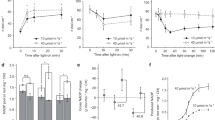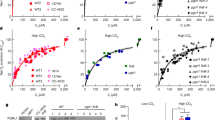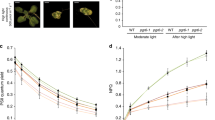Abstract
THE accepted pathway of CO2 fixation in plant photosynthesis requires that the photosynthetic light reactions produce ATP and reduced pyridine nucleotide (NADPH) in the molar ratio 3:2 (ref. 1). Early studies of photosynthetic phosphorylation suggested that non-cyclic electron transport could produce only equimolar amounts of ATP and NADPH, and the source of the extra ATP was presumed to be cyclic electron flow2. The view that the non-cyclic system is by itself able to produce twice as much ATP as NADPH has been expressed3,4, and removes the need for the in vivo operation of a cyclic electron flow which can be demonstrated in vitro only in artificial conditions5. An inflexible ATP–NADPH ratio of 2:1 for the products of the light reactions would, however, result in a feedback inhibition of electron transport, with ADP concentration as the limiting factor. One way of achieving flexibility in the relative production of ATP and NADPH would be for a low absolute stoichiometry of non-cyclic photophosphorylation (corresponding perhaps to a 1 : 1 ratio) to be accompanied by an ancillary reaction producing ATP but not NADPH. Such an ancillary reaction would be especially important in situations where ATP might be required for phosphorylations additional to those of the reductive pentose phosphate pathway.
This is a preview of subscription content, access via your institution
Access options
Subscribe to this journal
Receive 51 print issues and online access
$199.00 per year
only $3.90 per issue
Buy this article
- Purchase on Springer Link
- Instant access to full article PDF
Prices may be subject to local taxes which are calculated during checkout
Similar content being viewed by others
References
Gregory, R. P. F., Biochemistry of Photosynthesis, (Wiley, London, 1971).
Arnon, D. I., Whatley, F. R., and Allen, M. B., Science, 127, 1026–1034 (1958).
West, K. R., and Wiskich, J. T., Biochim. biophys. Acta, 292, 197–205 (1973).
Reeves, S. G., and Hall, D. O., Biochim. biophys. Acta, 314, 66–78 (1973).
Simonis, W., and Urbach, W. A., Rev. Pl. Physiol., 24, 89–114 (1973).
Heber, U., Biochim. biophys. Acta, 305, 140–152 (1973).
Telfer, A., Cammack, R., and Evans, M. C. W., FEBS Lett., 10, 21–24 (1970).
Arnon, D. I., Tsujimoto, H. Y., and McSwain, B. D., Nature, 214, 562–566 (1967).
Buchanan, B. B., and Arnon, D. I., Adv. Enzymol., 33, 119–176 (1970).
Egneus, H., Heber, U., and Matthieson, U., Hoppe Seylers Z. physiol. Chem., 355, 1190 (1974).
Whitehouse, D. G., Ludwig, L. J., and Walker, D. G., J. exp. Bot., 73, 772–791 (1971).
Heber, U., and Kirk, M. R., Biochim. biophys. Acta, 376, 136–150 (1975).
Patterson, C. O. P., and Myers, J., Pl. Physiol., Lancaster, 51, 104–109 (1973).
Allen, J. F., and Hall, D. O., Biochem. biophys. Res. Commun., 52, 856–862 (1973).
Hall, D. O., Rao, K. K., and Cammack, R., Biochem. biophys. Res. Commun., 47, 798–802 (1972).
Author information
Authors and Affiliations
Rights and permissions
About this article
Cite this article
ALLEN, J. Oxygen reduction and optimum production of ATP in photosynthesis. Nature 256, 599–600 (1975). https://doi.org/10.1038/256599a0
Received:
Accepted:
Issue Date:
DOI: https://doi.org/10.1038/256599a0
This article is cited by
-
Cooperative pathway of O2 reduction to H2O2 in chloroplast thylakoid membrane: new insight into the Mehler reaction
Biophysical Reviews (2022)
-
Energetic coupling between plastids and mitochondria drives CO2 assimilation in diatoms
Nature (2015)
-
Photobiological hydrogen production and artificial photosynthesis for clean energy: from bio to nanotechnologies
Photosynthesis Research (2015)
-
Evaluation of the participation of ferredoxin in oxygen reduction in the photosynthetic electron transport chain of isolated pea thylakoids
Photosynthesis Research (2010)
-
An active Mehler-peroxidase reaction sequence can prevent cyclic PS I electron transport in the presence of dioxygen in intact spinach chloroplasts
Photosynthesis Research (1994)
Comments
By submitting a comment you agree to abide by our Terms and Community Guidelines. If you find something abusive or that does not comply with our terms or guidelines please flag it as inappropriate.



